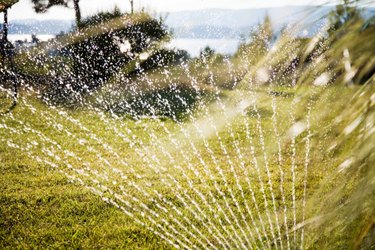
A rotating garden sprinkler makes an effective tool for demonstrating Newton's laws of motion. As water moves forward through the sprinkler, it generates an opposite force that spins the sprinkler arms in the opposite direction. Ask students to explain how the sprinkler works to test their knowledge of Newton's laws of motion.
Step 1
Show your students a rotational sprinkler in action. Ask them to describe what they see.
Video of the Day
Step 2
Mention Newton's third law in regards to the sprinkler: "Every action has an equal and opposite reaction." Ask the students to watch again while the sprinkler turns. They must watch specifically for the direction in which the water moves. The water always moves in the opposite direction to the sprinkler arms.
Step 3
Ask the students to consider what causes the sprinkler arms to rotate in the first place. If they get stuck, start with Newton's first law of motion: "An object in motion must stay in motion unless an external force acts against it to slow it down." Explain that in this case, the water moving through the sprinkler is the "object in motion". It moves faster as it moves towards the nozzle, in accordance with Newton's second law of motion: "An object acted upon by a force accelerates in the direction of the force." However, according to Newton's third law of motion, "Every action has an equal and opposite reaction." Thus, as the water is forced out of the nozzle, an equal force pushes against the sprinkler arms, causing them to rotate in the opposite direction of the water. Note that only the motion of the water causes the sprinkler to rotate. The sprinkler does not depend on electricity to keep the arms rotating.
Video of the Day